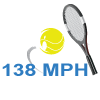Backhand – Single v/s Double Handed
There is a reason why the hardest and the most powerful backhand in the game belongs to Wawarinka and not Djokovic or Murray; and when it comes to power, Federer’s BH is as good as Djoko’s and Murray’s or anyone else with a two-hander for that matter. The single hander allows for generation of a longer and unrestricted swing path and if you are hitting it right the contact is ahead of the front foot which helps lengthen the swing even more. All of that translates into increased racket-head momentum which leads to more power being transferred into the ball at the point of contact. Therefore, the one-hander can be more powerful, versatile, and with better reach.
However, the two-hander is much easier to teach to kids and most local coaches do not want to take the pains and the risk of teaching the one-hander to them. Even parents do not have the patience to wait a year before their 9 year old can actually hit more than 2 balls across the net while learning the one-hander. Moreover, today’s game with modern day’s string technology has lead to an insane amount of spin generation which invariably results in balls rising above shoulder level for even the taller players, and playing high rising balls is the only disadvantage of a one-hander.
That disadvantage gets further exaggerated on return of kick-serves and while facing Nadal. The only way to deal with this disadvantage is to play inside or at the base line and take the ball very early and not allow it to rise too much; but slower courts and advancement in string-technology gives the advantage back to base-line players as they get enough time to reach even unreachable balls and return them with a vengeance. Moreover, you need real talent to take the balls really early and not too many players even at the very top can do that. Federer, of course has that talent but in the AO 2017 he was also helped by a relatively faster court which didn’t allow the likes of Djokovic and Nadal to track down every ball which they would have on a slower court.
Personally, I believe that the AO 2017 court speed should be the lower end; and other courts including Wimbledon should become even faster because the string technology is so advanced that practically most first serves can be returned by good players so the possibility of having a Sampras v/s Ivanivisic one shot display is non-existent.


Good article but I would take issue with one point. You say “…increased racket-head momentum which leads to more power being transferred into the ball at the point of contact.” But it is not just racket head momentum that counts, it is the momentum of the whole system including the arm, the body and ultimately the whole world if the player has feet on the ground.
It can be simplified into the velocity and effective mass of the racket head, where the effective mass depends on the rigidity of the grip. If you look carefully at the video of Stan, you can see the racket head decelerate sharply at impact as the grip flexes, then accelerate again after the impact. That deceleration is much smaller with a two handed grip and a rigid triangle connecting the racket to the body, because the effective mass is much greater. So the two-hander can get equal shot velocity from less racket head speed, taking less time to make the shot. Exactly the same principle applies to racket head stability. The more rigid grip is more forgiving of an off-centre shot in both power and direction. So there are theoretical advantages to the two-hander – it is not just easier to teach to kids.
For a tall doubles player, or really any doubles player, the one handed backhand is simply preferable, especially on the poach. But also the inside out high backhand slice drive can be a real weapon for a one hander. It is never expected. Hard to hit that with two hands. And then just the advantages of reach all over the doubles court with a one hander make it the shot of choice. Teaching kids, instructors should also be thinking 40 or 50 years down the road when, if they are still playing, most all will be playing doubles.